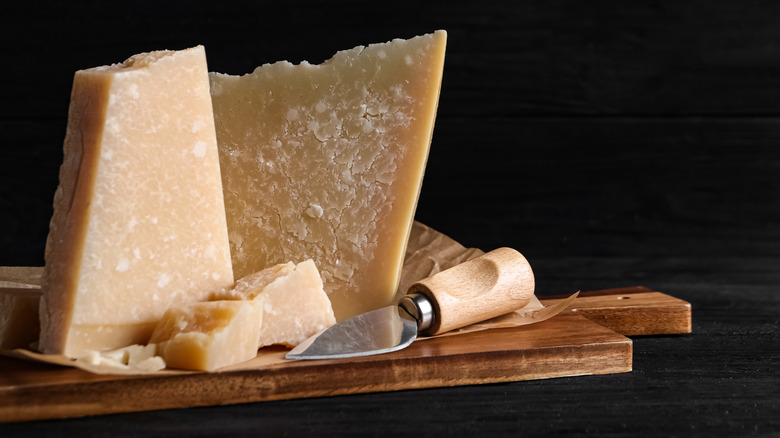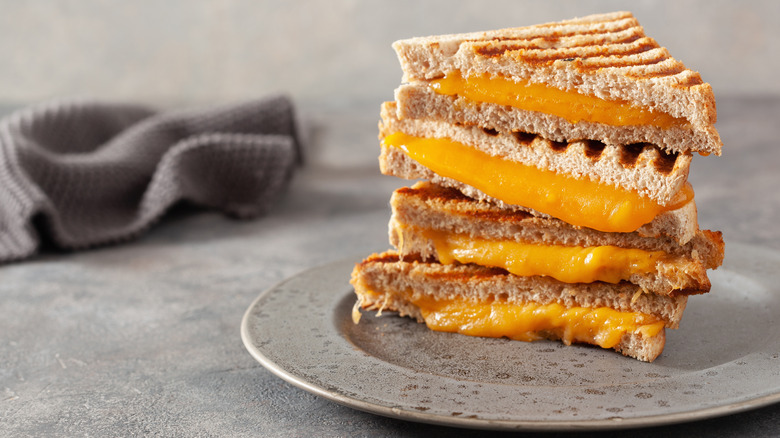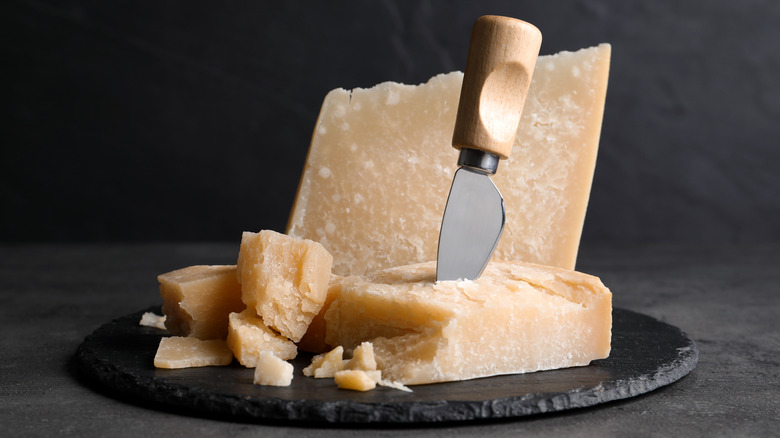What The White Stuff On Cheese Really Means
You've been craving the ultimate grilled cheese sandwich all day. And nothing else will satisfy the incessant nagging of your fussy little taste buds. Who can blame them? According to a YouGov survey, the grilled cheese is the nation's favorite sandwich with a whopping 79% giving it two thumbs up. And a poll conducted by Cheeseboy showed that 30% of Americans nosh on one of these ooey-gooey concoctions once per month, per Business Wire. Your taste buds, obviously, know what they're talking about.
You've mastered the secret to the best grilled cheese and can't wait to get started. As your hankering grows, you grab your frying pan, pull out two slices of bread, and reach for your brick of cheddar. Ack! There's something seriously wrong with your cheese. It's got tiny white spots all over it and the last thing you desire is a mouthful of melted mold.
Thankfully, there is no reason to panic just yet. Your chunk of dairy goodness may be perfectly edible. So tell your taste buds to take a chill pill while you investigate these mysterious snow-colored markings a little bit further.
Not all white patches indicate mold
Not all cheesy white patches are created equal. Some are, in fact, mold, while others are flavor-packed surprises that indicate a fully matured cheese. The trick is to decipher which one has taken residence in your cheddar. How on earth is someone supposed to do that? Thankfully, there is a way to avoid finding out what happens when you eat mold by accident. Food Scientist, Nicole Martin, told Eat or Toss, "If you see anything stick up from the surface, then it's more likely to be mold." The Spruce Eats adds that molds typically are on the outer portion of cheese and not in the inside, plus mold tends to be soft. Now that you've determined that your white patches aren't mold, you're left with another question. What the heck are they?
Those little white bits are likely one of two types of flavor crystals — calcium lactate or tyrosine. Unless you are scientifically minded, you are likely furrowing your brows or scratching your head in confusion right now, but don't fret. Both are harmless. In fact, the presence of either is a good thing. This means that your cheese has undergone some positive changes while it aged and is now fully flavored, per Life Hacker. Are your taste buds doing their happy dance?
Flavor crystals are a sign of well-aged cheese
How can you tell which type of crystals you have? The PH Cheese explains that calcium lactate is normally located on the surface and is often chalky or scaly, while tyrosine often lurks in the inner part of your cheese and tends to be firm and crispy. While calcium lactate can also appear in the interior it is most commonly on the outside.
Now that you've identified your culprit, what does this mean and how did it get there? Again, both are perfectly safe. In fact, this flavor-enhancing process may make cheese lovers everywhere rejoice. The Spruce Eats explains that as cheese gets older, bacteria go to work on the lactose, converting it to lactic acid. In turn, "lactic acid and calcium combine to create calcium lactate, which can form into calcium lactate crystals."
Cheese Science explains that the process that creates tyrosine crystals has do with Lactobacillus helveticus, something that is added to some cheeses to enhance their flavor. While they confess that tyrosine's formation is not yet completely comprehended, they do know that Lactobacillus helveticus "has a knack for breaking down peptides (i.e. protein chains) into free amino acids, tyrosine being one of them. As the tyrosine builds up it will eventually crystallize out." Now that you know the science behind these mysterious crystals, you can enjoy your cheese without fear. And, finally, those pesky taste buds will be silenced. Until the next craving.


